Want to see the Moonbow? Here are the spots where you can see them.
While in Yosemite this summer, we caught wind of the moonbow phenomenon. We had no idea what it was, but just so happened to be in the right place at the right time.
We felt extremely lucky to witness this rare wonder, especially when so many people plan trips out here with no guarantee to show up. That’s nature for you. Ever since seeing our first moonbow, we’ve been obsessed with seeing them all.
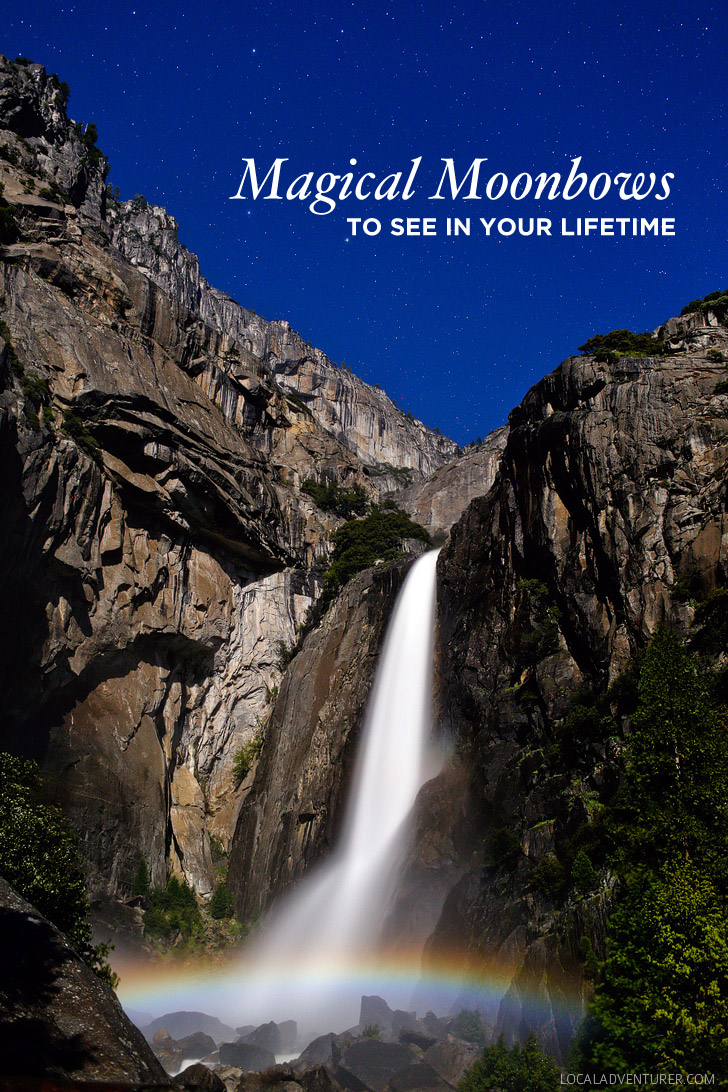
This post may contain affiliate links, where we receive a small commission on sales of the products that are linked at no additional cost to you. All opinions are always our own. Read our full disclosure for more info. Thank you for supporting the brands that make Local Adventurer possible.
Last Updated: February 17, 2025
TLDR
🌙🌈 Moonbows – A moonbow, also known as a lunar rainbow, is a rare phenomenon that occurs when moonlight is refracted through water droplets in the air, just like a regular rainbow but much fainter. They are most commonly seen near waterfalls or during nights with a bright full moon and plenty of moisture in the atmosphere.
🥾 Where to See Moonbows – Yosemite National Park, Cumberland Falls State Resort Park, Waimea Canyon State Park
📸 Photography Tip – Since moonlight is much dimmer than sunlight, moonbows often appear white to the naked eye, though long-exposure photography can reveal their full spectrum of colors.
7 Magical Moonbow Locations to Visit + Moonbow Dates
“Lunar rainbows or spray-bows abound in the glorious affluence of dashing, rejoicing, hurrahing, enthusiastic spring floods, their colors are distinct as those of the sun and regularly and obviously banded, though less vivid. Fine specimens may be found any night at the foot of the Upper Yosemite Fall, glowing gloriously amid the gloomy shadows and thundering waters, whenever there is plenty of moonlight and spray.” – John Muir
What is a Moonbow?
Moonbows are rainbows caused by the moon instead of the sun. They are rarer than rainbows because the weather and astronomical conditions have to be just right for them to appear. You’ll also see them referred to as lunar rainbow, moon rainbow, spray-bows, moonbows, lunar bow, night rainbow, or nighttime rainbow. Whatever it’s called, you get to see a rainbow at night.
See More: 17 Breathtaking Things to do in Yosemite National Park
What Causes a Moonbow?
Just like rainbows in the day, the water droplets have to be at the correct angle opposite the direction of the light source to reflect, refract, and disperse the light. Science! Sounds simple enough, but there are a lot of factors.
- The sky needs to be clear.
- It needs to be a full moon or near full moon. It’s usually 2 days before and 2 days after.
- No other bright light source can be present.
- There needs to be sufficient mist. Moonbows are more frequent in some parts of the world where waterfalls create a lot of mist, while other parts, they only occur in spring when enough water if flowing.
- There needs to be enough wind and in the right direction to pick up the mist.
See More: 11 Scenic Hikes in Yosemite National Park You Can’t Miss
What does it look like to the naked eye?
When you look up the moonbow meaning, it actusally defines it as an arch of white light. We can attest to that! Moonbows look more like a white or silver streak to the human eye. You will see the shape of the bow, but the colors just aren’t bright enough for our eyes to see. That’s where the magic of photography comes in!
Where can you see a Moonbow locations
Here are the spots around the world where you can see moonbows. Not all the locations have predictions, but we’ve included any info we’ve found. If you know of any other resources, let us know!
1. Moonbow Yosemite →
37.7472255,-119.5963623, map
Location: Upper & Lower Yosemite Falls, Yosemite National Park, California.
Where to Watch: Watch from the foot of either upper or lower falls.
Dates: April 21-25, 2024, May 21-25, 2024, June 19-23, 2024
If you plan on visiting Yosemite National Park, check out this site for predictions on dates and times!
See More: 15 Breathtaking Things to Do at Yosemite National Park
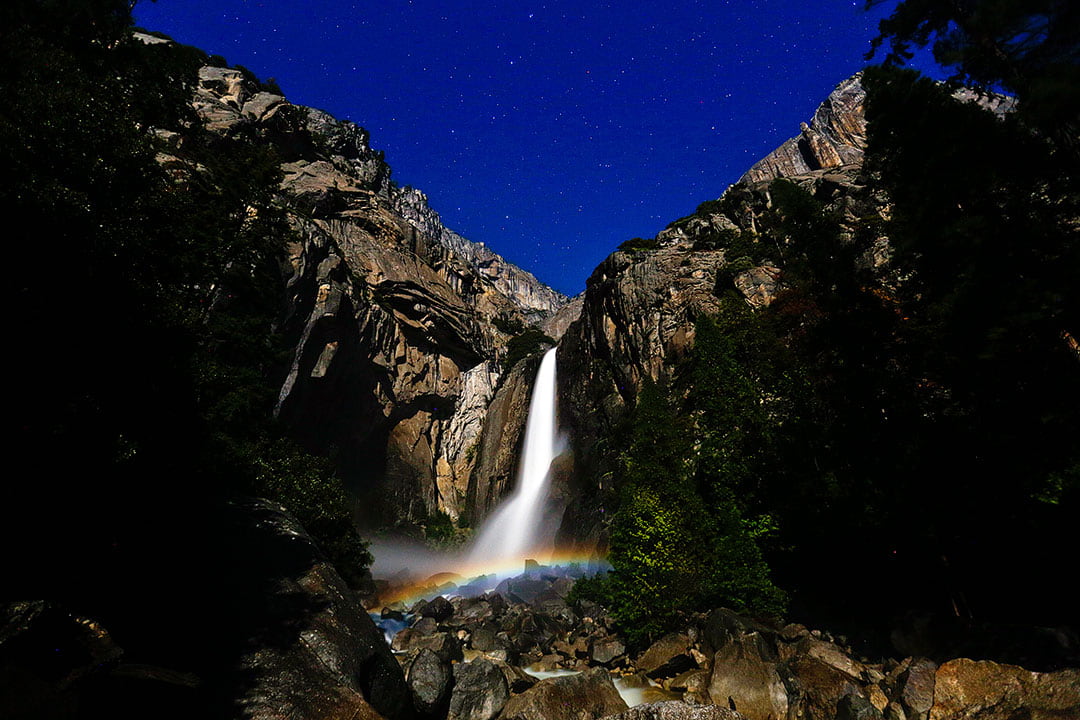
2. Moonbow Kentucky
36.8389694,-84.3555359, map
Location: Cumberland Falls State Resort Park, Kentucky
Where to Watch: See the Cumberland Falls moonbow from behind the railing at the upper overlook area.
Dates: At Cumberland Falls, there’s a chance it shows up every month, even December, around the full moon as long as all the other conditions are right.
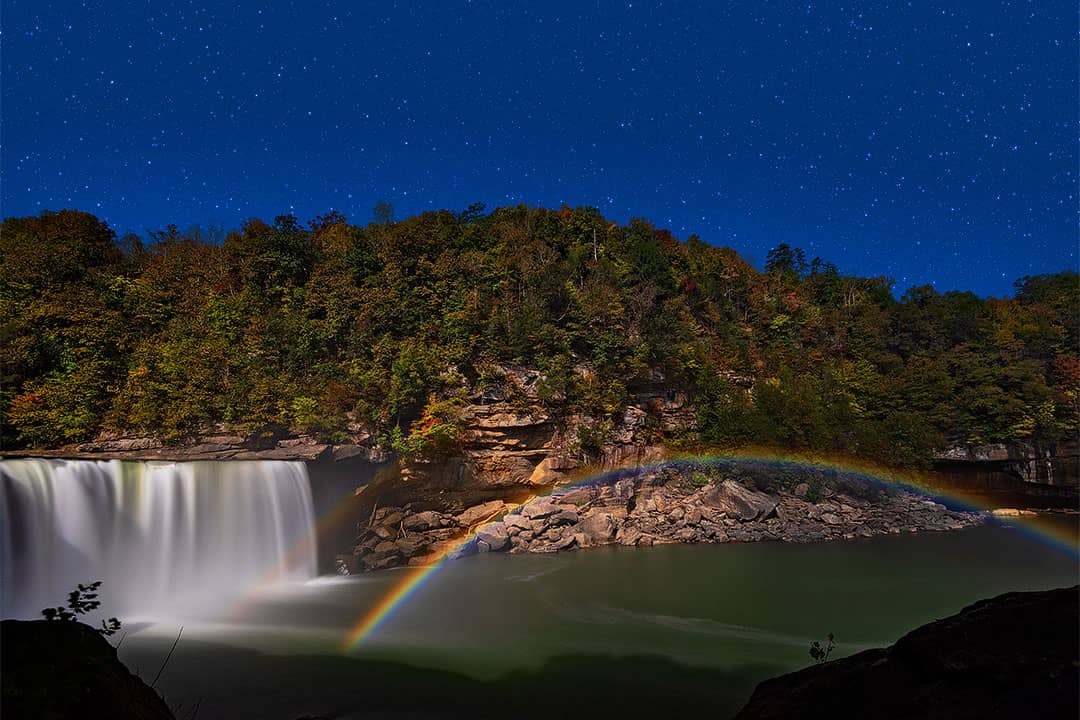
3. Zambia / Zimbabwe Moonbow
-17.9316798,25.806096, map
Location: Victoria Falls
Where to Watch: From the Victoria Falls Rainforest.
Dates: There’s a chance to see the moonbow year round, but the best months are typically June, July, and August. The 2024 dates are June 21-23, July 20-22, and August 18-20.
Tours to the Victoria Rainforest run three nights each month: the night before Full Moon, the night of Full moon, and the night after Full Moon. For more details on times, check here.

4. Moonbow Hawaii
22.0726785,-159.6681816, map
Location: Waimea Canyon State Park
We’ve seen photos of Moonbows captured at Waimea Canyon State Park but don’t have many details on where to see them. We’ve reached out to the park to see if they have any tips. Stay tuned!
5. Iceland Moonbow
63.5320123,-19.5139566, map
Location: Skogafoss Waterfall
Where to Watch: From along the river or up the trail.
Dates: Around full moon.
Skogafoss is a massive picturesque waterfall in Iceland. There is a huge parking lot and it’s often extremely busy during the day with tour buses. If you visit at night during the full moon, you have a chance to catch a Moonbow. Check out this shot of the Moonbow with the Northern Lights.
See More: Iceland Winter Road Trip – Best Stops and Places to Avoid
6. Australia Moonbow
-18.589556,145.8026239, map
Location: Wallaman Falls
Where to Watch: From the lookouts/viewpoints
Dates: Around full moon. Best from November to April.
This Moonbow doesn’t have any predictions. The falls flow all year, but the wet season runs from November to April, which means its fullest at this time and sprays the most. This photo was taken during the gibbous Moon showing that it doesn’t even have to be Full Moon for the Moonbow to show.
7. Arizona Moonbow
34.7469486,-112.1183551, map
Location: Jerome, Arizona
A rare shot of a Moonbow over Jerome, Arizona was captured in 2012. Based on the info we could find, I’m not sure that this one is predictable at all since it’s not based on a waterfall’s spray. Have you seen any other Moonbow photos from Jerome?
Map of Where to See a Moonbow
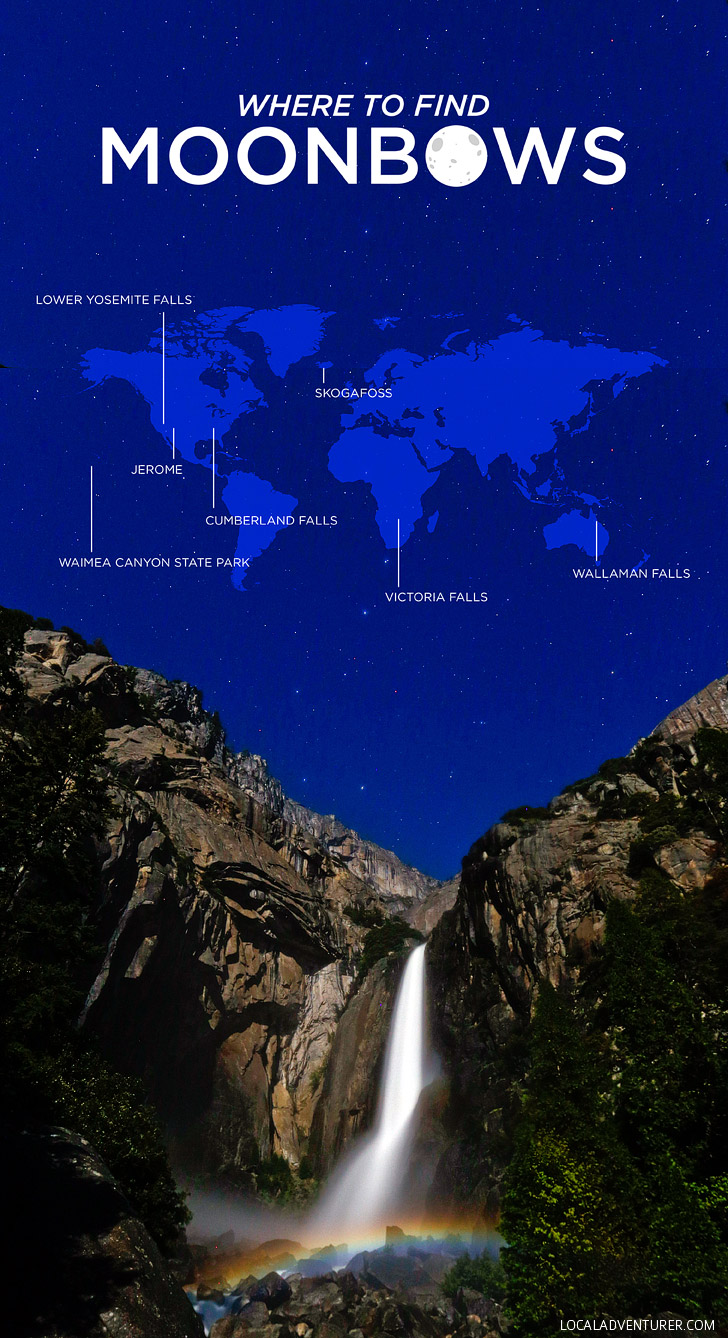
Photography Tips
- Gear You Need – You’ll be taking a long exposure. Use a tripod and remote shutter release.
- Get a rain cover for your camera if it isn’t weather sealed. Here’s a relatively cheap one that we use.
- Bring lens cloth to wipe your lens in between shots. It will get wet from the mist.
- Pack a rainjacket in case it’s extra misty.
- Bring extra batteries. Long exposure will eat up those batteries.
- Use headlamps with a red light feature. There were many photographers and a few of them kept turning on their headlamps super bright, which ruined other people’s shots.
- Camera settings. To capture moonbow images, start by using your night photography settings. My settings were 35mm, ISO 500, 8 sec, f/1.6. Then adjust based on how bright or faint the moonbow and surroundings are.
- Practice! Spend some time just shooting long exposures at home before you go out in the field. It’s harder to mess with settings when it’s dark out.
- Similar to northern lights, you may not see it well with your naked eye. Your camera can pickup things your eyes can’t.
Planning Checklist
- Get comprehensive insurance for your trip.
- Download these helpful language apps.
- Arrange a rental car for your trip.
- Get airport lounge access.
- Buy a travel charger to keep your devices charged.
- Get a new backpack for your trip.
- Pack the appropriate shoes for your trip.
- Don’t forget your in-flight essentials.
Have you heard about the moonbow phenomenon? Which one of these are you going to visit first / next?
Did you enjoy this post? Pin it for later
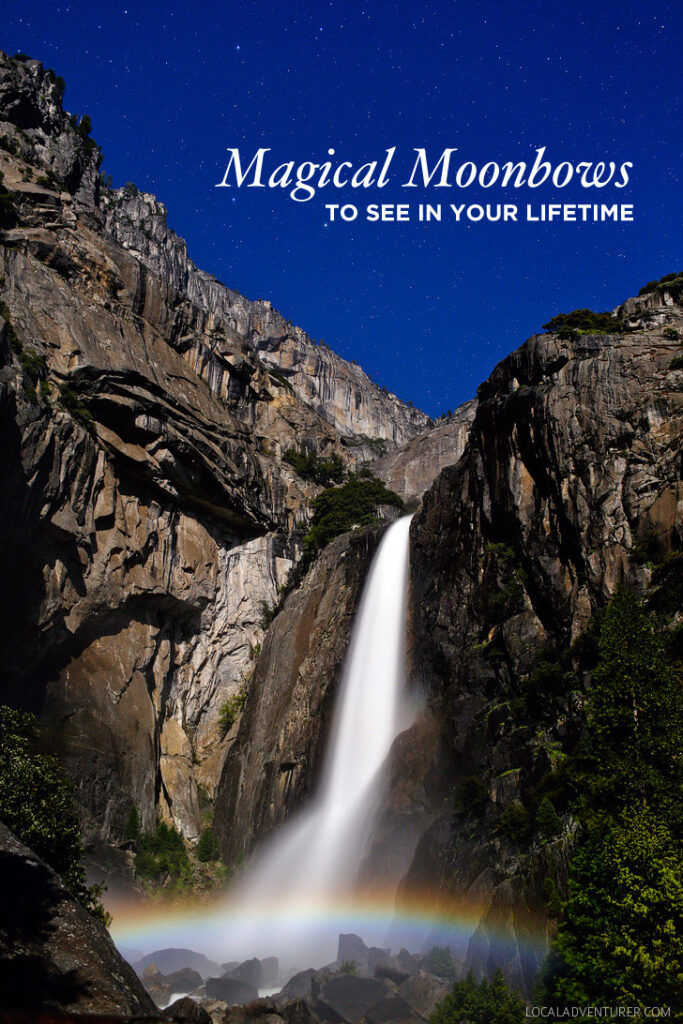
SEE More CITY Bucket Lists
⟡⟡⟡⟡⟡
“Discovery consists not of seeking new lands but in seeing with new eyes” – M. Proust
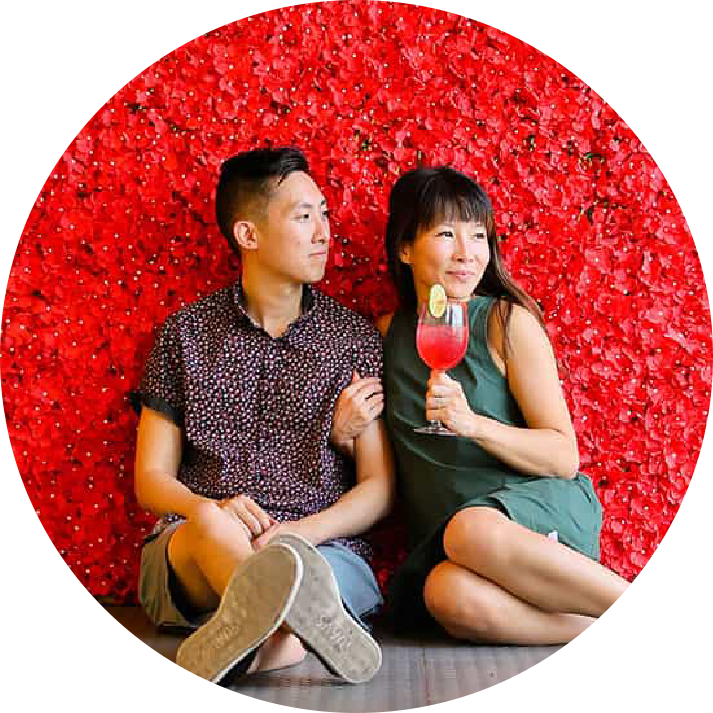
Esther + Jacob
Esther and Jacob are the founders of Local Adventurer, one of the top 5 travel blogs in the US. They believe that adventure can be found near and far and hope to inspire others to explore locally. They explore a new city in depth every year and currently base themselves in Las Vegas.
Follow on Instagram (E + J), YouTube, TikTok, and Pinterest.
